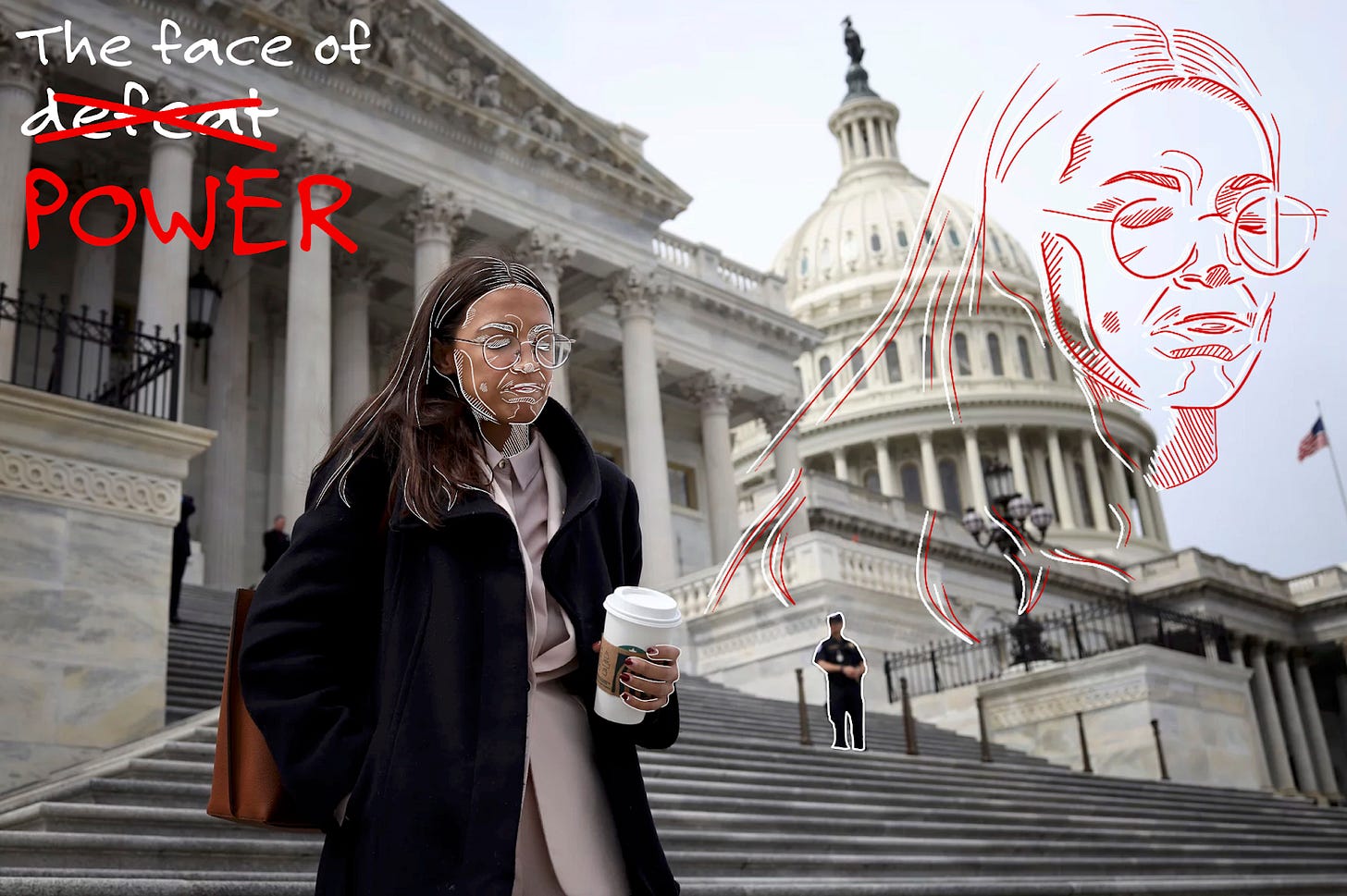Split Screen: Alexandria Ocasio-Cortez reclaims the frame
The New York congresswoman doesn't let others define her.
In June 2018, a 28-year-old bartender and community organizer defeated a 10-term Democratic incumbent in a congressional primary that shocked the Democratic political establishment. When Rep. Alexandria Ocasio-Cortez arrived in Congress six months later, she brought progressive policies, a fresh approach, and a new visual presence to the political landscape— one that traditional media struggled to frame.
As I've explored in previous “Split Screen” columns, women in politics face persistent patterns of visual sexism, including unflattering camera angles, excessive focus on appearance, and domestic rather than political framing. Ocasio-Cortez’s rise offers a compelling case study in these patterns—and a roadmap for how a new generation of women in politics can counter them.
For example, in this photograph from her Instagram page, Ocasio-Cortez looks out into a crowd. From a low angle, you look up at her – seeing the people who have gathered to see her speak. You see the microphone, get a sense of the stage. This is the type of photograph that shows a woman with authority and dignity. But, unfortunately, looking at how the media portrays her tells a different visual story.
The Vicious Cycle of Vicious Framing
Framing women with their mouths open and/or eyes closed remains some of most subtle yet powerful techniques for diminishing women's authority. Research on visual framing of women politicians consistently shows patterns that undermine their power. Based on her own experience running for office, researcher Karen Ross interviewed women in politics around the world and found that gendered coverage constitutes “routine journalistic behavior.”
This disparity doesn't happen by accident. As her star has risen, especially in pieces positing her potential presidential or vice presidential 2028 run, I see a trend of photos undermining her.
For example, a May 6 piece in The Hill asks with its headline, “Is AOC a viable 2028 candidate?” with a photograph of her mouth wide open, her skin color distorted, and her hand raised. The photograph these editors chose answers the question before readers even read the article.
In a March 18 piece on a poll about how well she reflects Democrats’ “core values,” the editors at KFox14 chose this photo. What does her expression convey to you, reader?
And in a Dec. 17 piece on her defeat to lead the House Oversight Committee, The New York Times selected a harshly lit close-up against an isolating black background. The lighting is so intensely dark and contrasted that even her eyelashes have shadows, and her eyes aren’t fully open. It’s likely she was blinking, or perhaps squinting from a spotlight, but this photograph makes her look tired.
After she was insulted on the House floor by a Republican congressman on July 23, 2020, NPR ran this image with her eyes closed, her expression in a defeated frown. Lost was a visual opportunity to show a woman standing up for herself, holding strong in her power against the compelling visual backdrop of the Capitol.
In an Aug. 28, 2019, article after Ocasio-Cortez dared to laud fellow millennials for being “informed” and “willing to go to the streets” in protest, The New York Post ran this photograph. It doesn’t take a cinematographer’s perspective to deconstruct why this image is awful. Photo selection is always a choice; clearly this was not the only photograph available to the editors. They chose visual sexism; they are still choosing visual sexism.
Taken together, these images tell our young women that if you speak up, if you are ambitious, if you dare challenge the status quo: you will be made menacing or, conversely, weak. Power in women seems too dangerous to frame with dignity, so instead we are framed otherwise.
Too Cheap and Too Expensive
Just as with Alaska Gov. Sarah Palin’s infamous wardrobe controversy, Ocasio-Cortez’s clothing receives disproportionate attention. Political scientists Danny Hayes, Jennifer Lawless, and Gail Baitinger, in their 2014 study "Who Cares What They Wear? Media, Gender, and the Influence of Candidate Appearance" published in Social Science Quarterly, note that though such appearance-focused coverage might seem trivial, it creates systematic disadvantages.
What makes Ocasio-Cortez’s case distinctive is the class dimension. Her clothing wasn’t criticized for being too expensive (like Palin’s designer wardrobe) but often for not being expensive enough—with commentators suggesting her choices indicated she didn’t look the part of a congresswoman. When she later wore designer clothing for a Vanity Fair photoshoot, she faced immediate criticism for appearing too polished.
Ocasio-Cortez herself has called out the misogyny of mainstream coverage focusing on women’s appearances. After facing criticism for a $250 haircut, she called out President Donald Trump for writing off $70,000 of hairstyling as a business expense. She tweeted, “Last year Republicans blasted a firehose of hatred + vitriol my way because I treated myself to a $250 cut & lowlights on my birthday. Where’s the criticism of their idol spending $70k on hairstyling? Oh, it’s nowhere because they’re spineless, misogynistic hypocrites? Got it.”
Women in politics must appear polished enough to be taken seriously but not so polished that they seem inauthentic or out of touch. The excessive focus on Ocasio-Cortez’s clothing creates a framework in which her appearance is subjected to scrutiny that her male colleagues simply don’t face.
By now, in 2025, journalists ought to be aware that women in politics face excessive criticism for their appearances. So when photo editors choose visually sexist images to accompany headlines about a woman’s appearance, they undermine not just that particular woman, but all women in all positions of power.
Reclaiming the Frame
What distinguishes Rep. Ocasio-Cortez from previous women politicians is how effectively she has countered traditional visual framing through social media. Whereas women from Rep. Shirley Chisholm to Secretary of State Hillary Clinton had to rely on mainstream media to communicate their visual presence for them, Ocasio-Cortez has leveraged Instagram, Twitter, and TikTok to create her own visual narrative.
Mainstream outlets often photograph her from high angles, with harsh lighting and bad color, her mouth agape, looking angry, stern, or disappointed. On her own social media, Ocasio-Cortez posts photos taken at eye level, looking focused, serious, and happy. Reporters frequently comment on her clothing; on her channels, in her voice, she explains the meaning behind her choices. She shares images of herself looking authoritative. Her social media strategy is brilliant because she writes her own visual story in a world of images created by others.
Ocasio-Cortez's strategic use of social media suggests a path forward for women in public life. When mainstream outlets frame her in limiting ways, she counter-frames through direct communication channels.
Just because Ocasio-Cortez is smart enough to leverage social media doesn’t mean the problem of visual sexism is solved. The burden shouldn't be on women to counter unfair visual framing; the framing itself should change.
Until mainstream visual media evolves, social platforms provide a crucial space for visual resistance. When Ocasio-Cortez livestreams from her kitchen while discussing policy, she reclaims domestic space as approachable rather than diminishing.
These visual counter-narratives don't just benefit women in politics—they also expand our collective visual imagination about what leadership looks like. When young people see Ocasio-Cortez confidently occupy political space on her own terms, despite traditional visual framings that try to diminish her, they can imagine themselves there too.
As viewers and citizens, we can contribute to this visual evolution: Question why certain angles, expressions, and contexts are chosen for women politicians. Notice patterns in how they're visually framed compared to their male counterparts. And seek out their own direct visual self-representation that social media makes possible.
Until next time, keep your eyes sharp and your lenses sharper.
Send examples of visual sexism you've noticed to submit@contrariannews.org with the subject line SPLIT SCREEN.
Gender Breakdown:
Total unique researchers: 4
Female researchers: 3
Male researchers: 1














As far as I'm concerned, AOC could dress as a Martha and I would still consider her as one of the most effective politicians of this age. I love everything about her, her eloquence, her effectiveness, her "fight oligarchy" tour with Bernie Sanders, her preparedness on congressional committees. everything.
She is the Democrats future, either as a successor to Nancy Pelosi, as President, or any other office she aspires to.
This article is so right on. My first real encounter with sexism began some 45 years ago when I started at Longs Drugs and the Manager asked this woman to teach me about the cash register. She said, and I've never forgotten it: "Oh great another guy I need to train to be my boss".
AOC became a very effective politician, I believe, because she listened to Nancy Pelosi early on. AOC seems has shifted her focus to bread and butter issues in lieu of only the social issues she seemed to focus on in her first years as a member of the House. I'd love her to eventually be Speaker of the House; but I don't believe she could ever be President (but who am I, as seventy year white guy who was shocked (and most presently so) when President Obama became President).